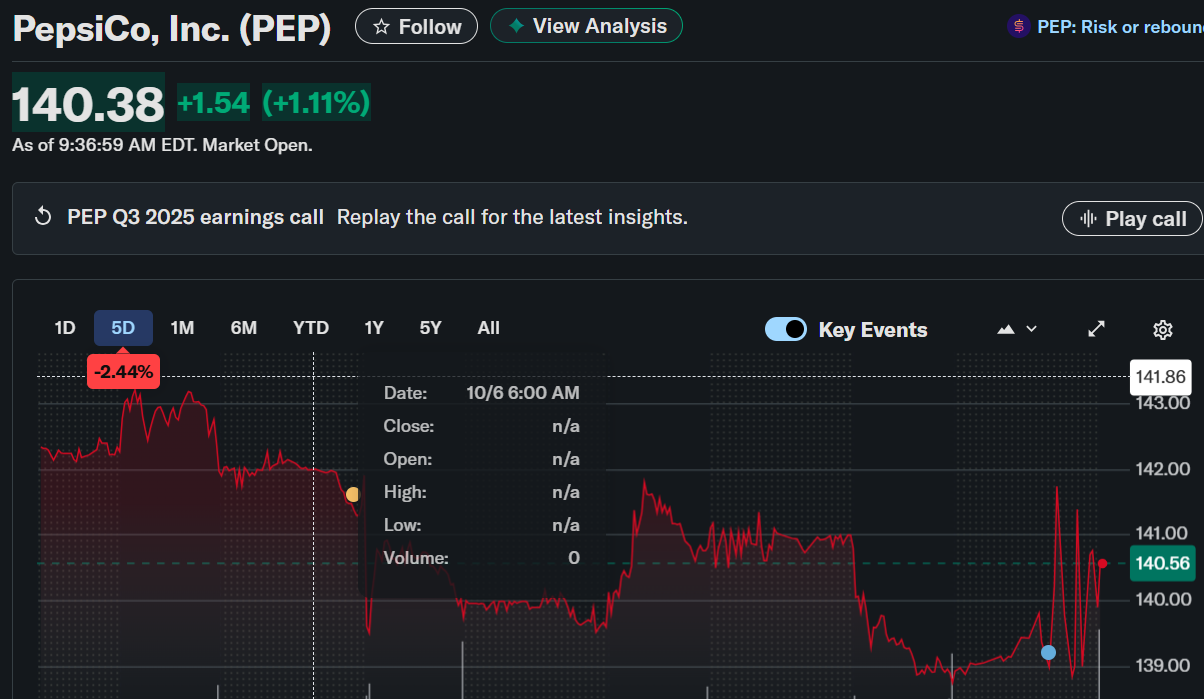PepsiCo Inc. (PEP) Stock: Q3 Revenue Tops Estimates as Beverage Unit Rebounds and Cost Cuts Accelerate
TLDR
- Q3 2025 revenue: $23.94B vs. $23.85B expected; EPS: $2.29 vs. $2.27 forecast.
- North American beverage sales grew 2%, the strongest in nearly two years.
- Activist investor Elliott Investment pushes for portfolio streamlining and refocusing.
- PepsiCo expands Poppi and launches healthier Doritos, Cheetos, and Lay’s variants.
- Stock trades at $138.84, down 1.39%, with pre-market gains of 0.22% to $139.15.
PepsiCo Inc. (NASDAQ: PEP) stock closed 1.39% lower at $138.84 on October 8, before inching up 0.22% to $139.15 in pre-market trading after reporting its third-quarter 2025 results.

PepsiCo, Inc. (PEP)
The company posted stronger-than-expected revenue and earnings, signaling a rebound in its North American beverage unit.
Revenue rose 2.6% year-over-year to $23.94 billion, surpassing Wall Street’s $23.85 billion estimate, while adjusted earnings per share (EPS) hit $2.29, slightly above expectations of $2.27. Net income, however, declined 11% to $2.6 billion.
CEO Ramon Laguarta attributed the solid results to the “resilience of PepsiCo’s international business, improved momentum within North America Beverages, and the benefits of portfolio reshaping actions.”
Poppi and Zero Sugar Drive Growth
The company’s North American beverage business grew 2%, marking its best performance in nearly two years. Growth was driven by Pepsi’s zero-sugar variant and Poppi, the prebiotic soda brand that PepsiCo acquired earlier in 2025. Poppi has been marketed as a healthier beverage option, helping PepsiCo capture younger, wellness-focused consumers.
However, the food division lagged, with Frito-Lay snack volumes down 2% and overall beverage volumes declining 3% in the region. International operations in Latin America and Asia reported higher sales volumes, which offset weaker U.S. demand.
Streamlining Under Investor Pressure
The results come amid renewed scrutiny from Elliott Investment Management, which recently took a $4 billion stake in PepsiCo and called for a strategic review of its business. Elliott has urged the company to streamline its portfolio, reinvest in high-performing brands like Mountain Dew, and explore refranchising North American bottlers to unlock value.
In response, PepsiCo has been cutting underperforming product lines to reduce supply chain complexity and accelerating cost reductions, particularly in its Frito-Lay U.S. operations. The company also plans headcount reductions before the end of 2025.
Healthier Snacks and Leadership Transition
PepsiCo is introducing new products aligned with shifting consumer preferences. It plans to roll out Doritos and Cheetos “NKD” — made without artificial colors or flavors — and revamp Lay’s with cleaner ingredients. It’s also launching higher-protein options, including Doritos Protein and meat snacks.
The company announced a leadership change: Jamie Caulfield, its current CFO, will retire, and Steve Schmitt, formerly CFO of Walmart U.S., will assume the role on November 10, 2025.
Performance Overview
PepsiCo’s year-to-date return is -5.96%, with a 1-year loss of 15.38% as of October 8, 2025. Over the past five years, the stock has gained 17.20%, compared to the S&P 500’s 95.94%.
Despite activist pressure and slowing snack demand, PepsiCo’s beverage turnaround, strategic cost management, and innovation-focused initiatives position it for steadier growth heading into 2026.
The post PepsiCo Inc. (PEP) Stock: Q3 Revenue Tops Estimates as Beverage Unit Rebounds and Cost Cuts Accelerate appeared first on CoinCentral.
You May Also Like

Mid-tier Bitcoin miners gain ground, reshaping post-halving competition
Smaller Bitcoin miners surge in hashrate and debt as competition intensifies post-halving, reshaping the industry’s balance of power. The Bitcoin mining industry is becoming increasingly competitive, with so-called tier-2 operators closing the gap on established leaders in realized hashrate — a sign of a more level playing field following the 2024 halving.According to The Miner Mag, companies such as Cipher Mining, Bitdeer and HIVE Digital have rapidly expanded their realized hashrate after several years of infrastructure growth, narrowing the distance to top players like MARA Holdings, CleanSpark and Cango.“Their ascent highlights how the middle tier of public miners — once trailing far behind — has rapidly scaled production since the 2024 halving,” The Miner Mag wrote in its latest Miner Weekly newsletter. Read more

Wormhole launches reserve tying protocol revenue to token
